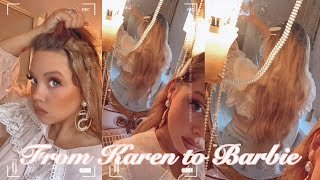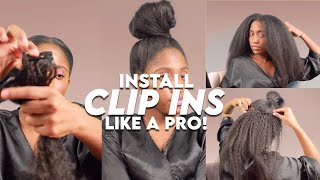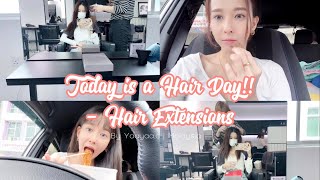How To: Cut And Blend Extensions
- Posted on 15 September, 2021
- Clip-in Hair Extensions
- By Anonymous
Just as important as installation, your cut can make or break your final look right now, i'm going to show you a couple of tips on how to cut blend and frame, to give you a seamless blend with your extensions to begin our cut. I always ask my guest to stand up that way. I can see where the extensions and where the hair is going to lay on her body, and i can determine where i need to cut to make sure i'm executing the look that she's going for next. I like to cut on dry hair as well extensions, don't grow away from the scalp the same way your natural hair does so in turn, it won't cut the same when it's wet. I like this to be a visual cut and i like to see where the hair is going to lay and that's why. I always like to cut on dry hair, whether you use thinning, shears, a razor or scissors. An important part of cutting is to make sure that you are always adding additional texture. Extensions do not cut the same way as natural hair, so it's important to constantly add that additional texture razors will give you that kind of texture that you're looking for with each stroke, whereas when you're working with shears you're going to want to use a little bit Of point cutting and slide cutting as well. Now that we've covered a couple of the basics, i'm going to roll into a very universal cut that you can use to blend any extensions. Okay, i'm going to begin by framing around her face. The reason why i like to start with framing is because, generally speaking, your guests like to leave their extensions as long as possible and when that's the case, the front area of her hair and the shortest layer. She has will usually determine how your framing will look and how long your extensions can be. I'M going to start by separating her hair and the hair forward of her ear, i'm just going to bring it a little bit forward and wherever her hair ends. That is where my extension framing will begin and i'm going to use a razor and just slide down very softly, and i always use a fresh razor blade and even though i go over it a couple of times, i always try to stay very conservative. With my cut, because, if i take it away, i can't put it back on and you can see how nice that framing is starting to come into play and how much more natural these extensions are when they're blending with her own hair and every time i come Up to do another stroke, i always look for the natural hair. As my guide, i'm going to have her turn around and i'm gon na bring the hair from the front to the back, and this is when we will determine what the shape of her hair will be. It can be more of an exaggerated v. It can be a u shape, it can be straight across it's just whatever her preference is and how she would like. Her final look to be. I also like to swing my cape around, so i have a clean palette to work on there we go. I know my model wants to keep as much of the length as possible, but i can see what needs to be cleaned up and i would say it's all of about an inch and a half to give it a really nice defined weight line. So what i'm going to do is, i am actually going to ask my model to rather than stay stand up straight up, i'm going to ask her to roll her shoulders forward very slightly, and you can see it creates a much more exaggerated platform. For me to be able to cut on because this is again going to be visual, so you can see from here exactly what i need to cut and once i create my guide for my length, which is about here, i'm going to use my guide that i Just created for my length in the back and my framing in my front as my additional guide and all i have to do is match my guides together to create the shape that i want, and you can do this with a razor as well as shears. I actually like to use both when i'm doing this to get more defined and precise cuts, but still keeping that texture that is so necessary when you are working with extensions. Okay, once you've created your shaping, you can ask your guest to stand up straight again and you'll see it all flows back at this point, you can see i've created a nice defined weight line and shape, and now we can move on to our layering with the Way that you've done your installation for a full head, it's already built into long layering. However, if you're looking for more defined layering, this is the time that you would do that cut a softer, more blended layering. You will want to pick up vertical sections, just like we do with our natural hair. However, with extensions you do not want to lift or elevate above 45 degrees, i always stay below 45 degrees again, because it's a visual cut, we want to see where the hair will lay and see what kind of movement that creates right. Now we're working on a very blank canvas with roma and it's all basically one length if you are looking to create more defined layers as opposed to picking up your vertical sections, you are going to pick up horizontal sections using each row of your extensions as your Guide, rather than starting at the bottom, and taking away from your heavier weight line that you need to make it look like your hair. Is this new extended length? You will want to start your layers at the top moving your way down towards the nape area. When i lift this up, you will notice that i'm not taking away from the sides i'm leaving this area, because i've already established my framing what i want to create is additional layering in the back. So it's only going to be from this back area right here. I'M going to bring this hair down lower than 45 degrees. Okay, i'm going to bring this hair down lower than 45 degrees, and i'm just going to begin and wherever her hair ends, usually about 2 inches past her natural ends from her top area and her crown is where i like my layering to begin and my first Layer in my extensions to start with my razor, you can see i'm using longer strokes, so i have more control over how much hair i'm taking off slow and steady. That'S my first layer and now, once i've dropped down my first layer, i'm going to move her hair and you can see what i've established it's time for my next layer. My next layer is going to be my next row. Just underneath the row i cut i'm going to use my previous layer as my guide and my next layer is going to begin about two inches lower than where that layer ended. And at this point i can see my layers are coming closer to where my weight line is, and this is when i can begin to texture and blend with vertical sections. I have you turn just very slightly perfect, because we cannot install in the crown area. You might see a jump between her natural hair and the extensions, even though you've layered, even though your blend is correct. The best thing to do to help blend this top area of her natural hair into the extensions, especially when you have a heavy shelf or a weight line. If you go in and point cut, you're going to start taking away length, which is what you need to blend into the extensions, if you razor on top you're, creating more texture, more layers and more work for yourself, we need to take away from this dense weight Line without removing length and really leaving everything intact on the top area. So what you're going to do is you're going to take your razor and you're going to come in from underneath at mid shaft, and you are going to very gently carve in and remove that excess density from her natural hair, which will allow the extensions to blend Seamlessly into the natural hair - and you can use this technique anywhere on the head, where you see there's additional density or bulk that you want to remove. But you want to leave the top area intact, and this same technique can be used in the front of the hair as well. If you feel, like you, see a drop off or a shelf as some people like to call it i'll go in cut in very slightly and again, this is very minimal, because if you cut too much, you will start to take away length finally, and have roma Turn around part in the middle bring it forward. Our final technique for cutting is going to be just polishing and refining. Now, when she pulls her hair forward, you might notice her natural hair and the extensions, because her natural hair is textured and the extensions are all one length. We need to add a little bit of texture to the interior right in here to give a natural illusion and a natural blend of extensions and natural, and once we've finished our cut, this is when we can go in. We can polish her off by flat ironing using a smoothing brush or even curling.





Comments
Girlseagoat: This is the most beautiful blend I’ve ever seen done omg I wish she could do my hair I would actually do tape ins or something again lol
VentiTheBard: Wowwwwww. Would love to see this done with the shears :) but this is AMAZING!
Sereny S.: Beautifully explained!!
umbrella_inferno: This model looks so nervous when she starts cutting!
Gigi Ghibon-Elhenawy: What color are those extensions ? I absolutely love Bellami !!!
Krystal Gomez: So satisfying to watch
Infertilidad & Maternidad: Thanks thanks
TA L.: These extensions are tape-ins? If she had clip-ins wouldn't the position change on each application? Just wondering. Thank you.
Kelly Reinhold: Looks good in the end but man as a hairstylist I was cringing the entire time she was drafting that razor along dry damaged hair. I’ve always had belami extensions and they’re good but hers actually look quite damaged and dead. I’m sure it’s mostly cuz of the natural fried hair on top.